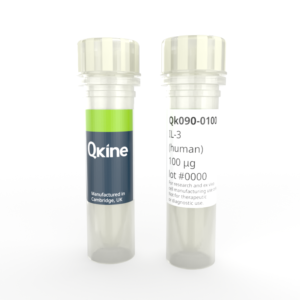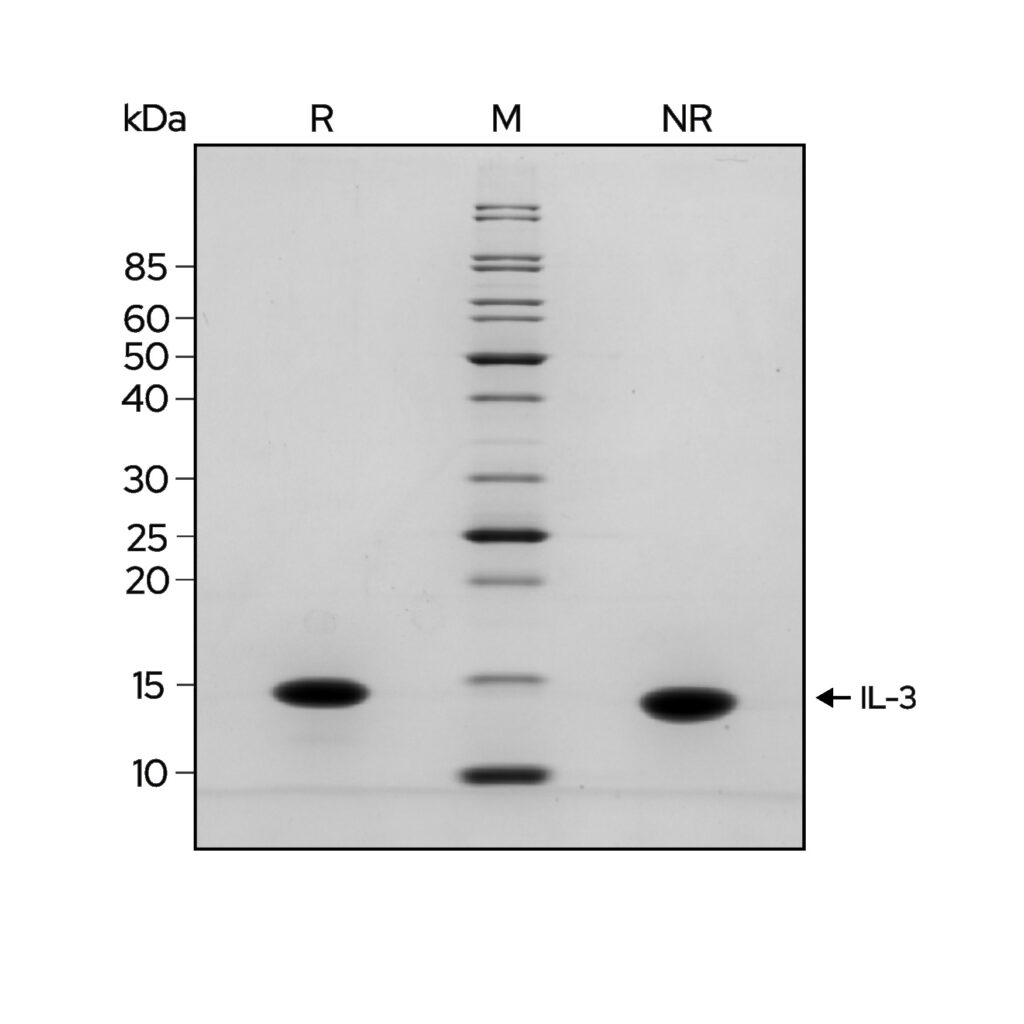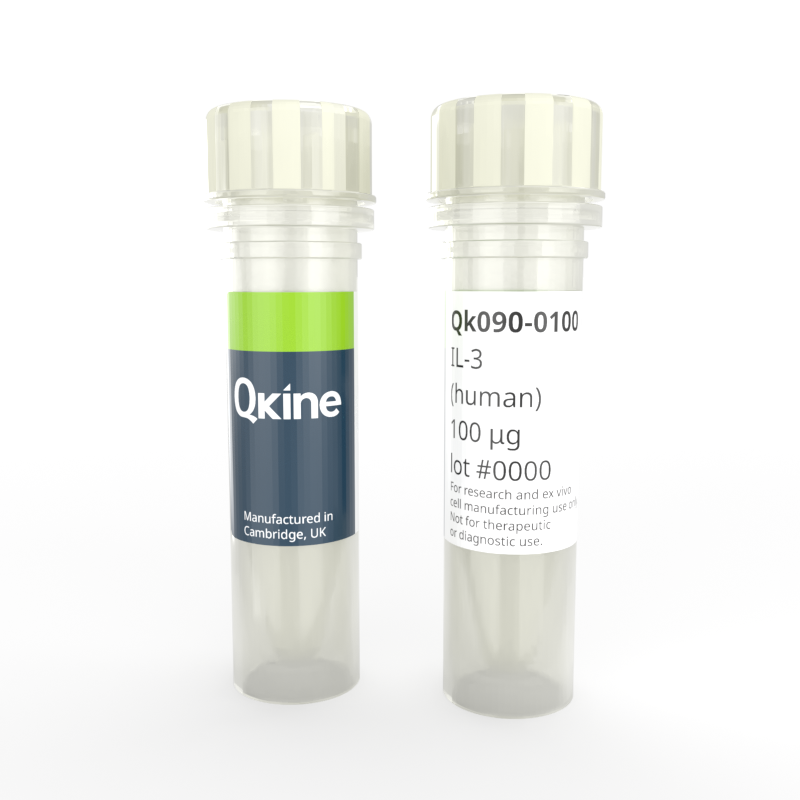 Recombinant human IL-3 protein (Qk090)
Recombinant human IL-3 protein (Qk090)Recombinant human IL-3 protein (Qk090)
Price range: £230.00 through £2,900.00
Recombinant Human Interleukin 3 (IL-3) is a pleiotropic cytokine which plays a crucial role in hematopoiesis and acts as a multi-lineage growth factor. As a hematopoietic growth factor, it promotes the proliferation, differentiation, and survival of various hematopoietic stem cells towards myeloid progenitors. IL-3 is commonly used in cell culture to stimulate the differentiation and maturation of human induced pluripotent stem cells towards mast cells, basophils, neutrophils, eosinophils, monocytes, and megakaryocytes.
Human IL-3 comprises 140 amino acids with a molecular weight of 15.2 kDa. This protein is animal origin-free, carrier protein-free, and tag-free to ensure a homogenous population with exceptional lot-to-lot consistency. IL-3 is suitable for reproducible and high-quality myeloid progenitors and more specific lineages.
In stock
Orders are typically shipped same or next day (except Friday).
Easy world-wide ordering, direct or through our distributors.
Price range: £230.00 through £2,900.00
Buy online with secure credit card or purchase order. For any questions, please email orders@qkine.com
Summary:
- Highly pure human protein (UniProt: P08700)
- 15.2 kDa (monomer)
>98%, by SDS-PAGE quantitative densitometry
Expressed in E. coli
Animal origin-free (AOF) and carrier protein-free
Manufactured in our Cambridge, UK laboratories
Lyophilized from acetonitrile, TFA
- Resuspend in 10 mM HCl (Reconstitution solution A) at >50 µg/ml, add carrier protein if desired, prepare single-use aliquots and store frozen at -20 °C (short-term) or -80 °C (long-term)
Featured applications:
Differentiation of myeloid progenitors into erythrocytes and megakaryocytes
Differentiation of peripheral blood monocytes to myeloid lineages
Generation of iPSC-derived myeloid and lymphoid progenitors
Maintenance and differentiation of hematopoietic stem cells
Maintenance of peripheral blood cells
- Recombinant human GM-CSF protein (Qk076)
- Recombinant human G-CSF protein (Qk074)
- Recombinant human M-CSF protein (Qk075)
- Recombinant human IL-6 protein (Qk093)
- Recombinant human TNF-alpha protein (Qk083)
- Recombinant human IL-8 protein (Qk119)
- Recombinant human TPO protein (Qk098)
- Recombinant human IL-34 PLUS™ protein (Qk091)

IL-3 activity was determined using proliferation of TF-1 human myeloid leukemia cells. EC50 = 102 pg/ml (6.7 pM). Cells were treated in triplicate with a serial dilution of IL-3 for 72 hours. Cell viability was measured using the CellTiter-Glo (Promega) luminescence assay. Data from Qk090 lot #204548.
Recombinant IL-3 migrates as a major band at approximately 15.2 kDa in non-reducing (NR) and reduced (R) conditions. No contaminating protein bands are present. The purified recombinant protein (3 µg) was resolved using 15% w/v SDS-PAGE in reduced (+β-mercaptoethanol, R) and non-reduced conditions and stained with Coomassie Brilliant Blue R250. Data from Qk090 batch #204548.

Further quality assays
Mass spectrometry: single species with expected mass
Recovery from stock vial: >95%
Endotoxin: <0.005 EU/μg protein (below level of detection)
We are a company founded and run by scientists to provide a service and support innovation in stem cell biology and regenerative medicine. All our products are exceptionally high purity, with complete characterisation and bioactivity analysis on every lot.

Qkine IL-3 is as biologically active as the comparable alternative supplier protein. Stimulation of proliferation of TF-1 cells with Qkine IL-3 (Qk090, green) and alternative supplier IL-3 (Supplier B, black). Cells were treated in triplicate with a serial dilution of IL-3 for 72 hours and proliferation measured using the CellTiter-Glo (Promega) luminescence assay.
Technote | IL-3 (Qk090) bioactivityProtein background
Interleukin 3 (IL-3) also known as B-cell stimulatory factor 2/interferon beta 2, is a pleiotropic cytokine with a crucial role in hematopoiesis and multi-lineage growth factor [1–4]. It promotes the proliferation, differentiation, and survival of hematopoietic stem cells and myeloid progenitors [3–6]. IL-3 induces the development of mast cells, basophils, monocytes, erythrocytes, and megakaryocytes and mediates the release of mediators from these cells. It is also involved in the recruitment of myeloid cells to inflammation sites and regulating T-cell function [2].
IL-3 is a monomer glycoprotein composed of 140 amino acids with a molecular weight of approximately 15.7 kDa [7]. The primary structure of IL-3 includes four alpha helices and a bundle of beta sheets stabilized by disulfide bridges [8]. It is produced by various cells including activated T cells, B cells, macrophages, monocytes, mast cells, vascular endothelial cells, and fibroblasts [5]. IL-3 binds with high affinity to the IL-3 receptor (IL-3R) of the hematopoietic receptor superfamily expressed on hemopoietic progenitor cells, monocytes, and B lymphocytes. Ligand stimulation of IL-3R induces tyrosine phosphorylation of effector proteins which subsequently trigger a cascade of intracellular responses such as the PI3k/Akt, Ras/ERK, and MAPK pathways [9,10]. IL-3R is heterodimeric and is composed of two subunits: an alpha subunit (IL-3Rα) and a beta subunit (βc) [11]. IL-3Rα is specific to IL-3, while βc is shared with other cytokine receptors, including those for IL-5 and granulocyte-macrophage colony-stimulating factor (GM-CSF) [5,10,12].
IL-3 is used in cell culture for the maintenance of peripheral blood cells13 and to induce the expansion and differentiation of hematopoietic stem cells [14]. IL-3 acts synergistically with IL-6 to enhance the proliferation of hemopoietic progenitors1. IL-3 is also used as an early regulator for the differentiation of induced pluripotent stem cells into myeloid and more specific lineages using other lineage instructive cytokines [14,15]. For example, antigen-presenting cells can be derived with the addition of GM-CSF and IL-4 for dendritic cells or M-CSF for macrophages [15]. Finally, IL-3 is also used as a growth factor for the differentiation of erythrocytes with IL-12 and megakaryocytes with IL-6 [16,17].
IL-3 has been studied for conditions which could benefit from the production of early myeloid progenitors and hematopoietic recovery [2]. These include bone marrow reconstitutions, aplastic anemias, and bone marrow disorders such as acute myeloid leukemia and myelodysplastic syndromes [2,18]. Research into the use of IL-3 in immunotherapy and cancer treatment is ongoing, as it may enhance the anti-tumor immune response. For example, the IL-3 and IL-3R axes could be potential therapeutic targets to treat acute myeloid leukemia [10,18,19]. Finally, the potency of IL-3 in amplifying acute inflammation makes it a potential therapeutic target in sepsis [20].
Our products are for research use only and not for diagnostic or therapeutic use. Products are not for resale.
For use in manufacturing of cellular or gene therapy products. Not intended for in vivo applications.

Receive an Amazon gift voucher when you leave us a review.
£25, $30 or €30 for reviews with an image and £10, $15 or €15 for reviews without an image
